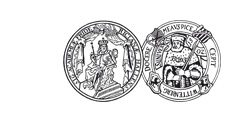Project Archive
Here you can find former projects of the Image Analysis group as well as of the chair for pattern recognition and bioinformatics headed by Prof. Dr. Stefan Posch until 2022.
Overview
- Analyse von PET-Scans zur Verlaufsprognose für Patienten mit Hodgkin-Lymphom
- Biological and bioinformatic analysis of TAL effectors in the Xanthomonas oryzae - rice interaction (DFG funded)
- 3D reconstruction of barley plants
- Marvin - Computer Vision on a Mobile Platform
- Weitere Forschungsthemen waren...
Analyse von PET-Scans zur Verlaufsprognose für Patienten mit Hodgkin-Lymphom

Das Hodgkin Symndrom ist eine maligner Tumor des Lymphsystems, der vorwiegend bei Kindern und Jugendlichen auftritt. Die Heilungsaussichten sind mittlerweile sehr gut, jedoch treten insbesondere aufgrund von Radiotherapien starke langfristige Nebenwirkungen auf. In diesem Projekt sollen auf der Basis von PET-Untersuchungen der Glukoseaufnahme (FDG-PET) prognostische Faktoren identifiziert werden, die perspektivisch zur Risikobewertung und Therapiesteuerung genutzt werden können. Der entscheidende Ansatzpunkt für die Arbeiten ist der aktuelle Stand der Diagnosik, bei dem das Ausbreitungsmuster nur sehr grob berücksichtigt wird. Im Projekt wird das Ausbreitungsmuster des Tumors mittels automatischer Segmentierungsverfahren und geeigneter Merkmale sowohl auf der Ebene von Körperregionen mit hoher Glukoseaufnahme (sowohl Normalgewebe wie auch Tumornester) wie auf der Ebene des gesamten PET-Scans der Patient*innen charakterisiert. Hierauf aufbauend werden Verfahren des maschinellen Lernens genutzt, um Normal- von Tumorgewebe zu unterscheiden und automatisch eine Verlaufsprognose zu ermitteln.
Drittmittelgeber: Mitteldeutsche Kinderkrebsforschung
Kooperationspartner:
- Prof. Regine Kluge und Thomas Georgi,
Klinik und Poliklinik für Nuklearmedizin, Universität Leipzig
Biological and bioinformatic analysis of TAL effectors in the Xanthomonas oryzae - rice interaction (DFG funded)

TAL effector

RVD binding specificities
PI: Dr. Jan Grau
This project aims at advancing our understanding of the interaction between plant pathogenic bacteria and their plant hosts. To this end, we will study transcription activator-like effector (TALE) function using the economically important model system Xanthomonas oryzae and rice (Oryza sativa). We follow an interdisciplinary approach combining biological and bioinformatics work packages. In the biological part we will identify TALEs from different, presently uncharacterized X. oryzae strains. Transcriptomics (RNA-seq) will reveal which target boxes of TALEs are functional in vivo and will also allow us to identify TALE target genes. Systematic reporter assays of target boxes in their promoter context will allow us to dissect different biological determinants of TALE function. The bioinformatic part will support TALE repertoire dissection and TALE target gene identification. In addition, the data generated in the biological part will be used in algorithms to further define in vivo TALE-DNA binding rules, and identify promoter characteristics or specific elements that are required for TALE-mediated gene-induction. Using this interlaced approach, the project will shed significant light on the biological activity of TALEs which will be instrumental to develop future resistant rice.
Collaborator:
PD Dr. Jens Boch, Dept. of Genetics, Institute of Biology, Martin Luther University Halle-Wittenberg
3D reconstruction of barley plants

An important research topic in agriculture is the identification of stress-resistent or high-yield barley genotypes. For identifying such genotypes various different types are sowed and during their growth period pnenotypical numbers like height, number of leafs, or the flowering time are manually aquired in regular intervals. We are working on automated procedures to simplify these monitoring procedure. In particular we seek to reconstruct the plants in 3D from multiple views acquired from different view points. Once 3D data is available all phenotypical data of interest can easily be extracted.
Cooperations:
Plant Breeding Group, Martin Luther University Halle-Wittenberg, Prof. Dr. Klaus Pillen
Dr. Armagan Elibol, at that time with the Korea Advanced Institute of Science and Technology (KAIST)
Marvin - Computer Vision on a Mobile Platform

Our mobile robot Marvin mainly participates in lectures we offer at the Master's level. Marvin serves as a mobile platform for investigating computer vision algorithms, e.g. dealing with collision avoidance, indoor navigation or human-machine-interaction in general. But, working with Marvin is not restricted to image analysis and computer vision. Besides the Kinect camera offering 3D data of the environment, the sonar and the integrated microphones also allow for work in other areas of signal processing. Furthermore of course Marvin requires an elaborate control system subsuming its logic and planning modules, which is also continously improved.
Weitere Forschungsthemen waren...
- Mosaikbilder
- Statistische Analysen von Microarraydaten
- Korrektur von Überstrahleffekten in cDNA-Microarrays
- Proteindocking
- Perzeptives Gruppieren
- Amperometrische Biosensoren




